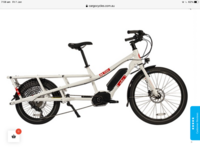bigcanoe
Member
Hey! I purchased a Lectric XP step thru a few weeks ago. Its a great bike but I am thinking its not the right fit for me and my riding environment. I live in the country and there are no nice paved bike paths nearby. I am usually riding potholed dirt roads or on the side of the paved back roads with traffic, which also have potholes. The potholes hurt! I was thinking a 26" fat wheel bike with suspension may be a better choice for me. I may sell this and go for a Himiway or Rad Rover. Anyone have insight to share?
